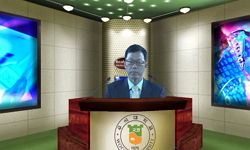자연환경, 건축환경, 경관 등이 오랜 시간에 걸쳐 진화되어진 공간 또는 대상을 문화경관이라 하겠다. 이런 관점에서 볼 때 제주특별자치도 소재 대정향교는 전통적이고, 유교문화경관이라 ...
http://chineseinput.net/에서 pinyin(병음)방식으로 중국어를 변환할 수 있습니다.
변환된 중국어를 복사하여 사용하시면 됩니다.
- 中文 을 입력하시려면 zhongwen을 입력하시고 space를누르시면됩니다.
- 北京 을 입력하시려면 beijing을 입력하시고 space를 누르시면 됩니다.
제주도 대정향교와 유교문화경관 연구 = ARTICLES : A Study on the Confucian Cultural Landscape of Daejeonghyanggyo at Jeju Island
한글로보기https://www.riss.kr/link?id=A101832866
- 저자
- 발행기관
- 학술지명
- 권호사항
-
발행연도
2015
-
작성언어
Korean
-
주제어
고지도 ; 유교적 문화경관 ; 의례 ; 전당후재 ; 전학후묘 ; D/H비 ; 풍수지리 ; Antique maps ; Confucian Cultural Landscape ; D/H Ratio ; Jeondanghuchae ; Jeonhakhumyo ; Peng Shui ; Ritual
-
자료형태
학술저널
-
수록면
17-33(17쪽)
- 제공처
-
0
상세조회 -
0
다운로드
부가정보
국문 초록 (Abstract)
자연환경, 건축환경, 경관 등이 오랜 시간에 걸쳐 진화되어진 공간 또는 대상을 문화경관이라 하겠다. 이런 관점에서 볼 때 제주특별자치도 소재 대정향교는 전통적이고, 유교문화경관이라 하겠다. 조선 태종16년(1416)에 대정현성 내에 신창되어 효종4년(1653)에 단산으로 이건하여 오늘에 이르고 있는 유구한 역사를 가진 곳이다. 이러한 문화경관 자원을 문화콘텐츠화하기 위해서는 진실된 가치와 의미를 파악하는 것이 매우 중요하며, 본 연구는 이것을 밝히기 위하여 진행하였다. 연구의 결과로 대정향교가 갖는 유교문화경관의 특징을 다음과 같이 밝혔다. 즉 대정향교의 신창과 이건에 따른 변화과정, 고지도를 통한 입지적인 해석, 주변환경의 생태적인 해석, 배산으로서의 단산 지명에 대한 풍수지리적인해석, 대정향교의 유교적 경관구조로서의 배치형태, 마당의 D/H비례, 대성전과 명륜당의 배치 각도에 있어서 유교문화경관의 특징을 파악할 수 있었다. 이상의 연구를 통하여 볼 때 제주도라는 단절된 섬 지역에서 유교적 교화를 실현하기 위하여 건립된 대정향교는 지역성을 고려한 유교문화경관의 특징이 가장 잘 드러나도록 조성된 사례라 하겠다. 향후 본 연구를 통하여 도출된 문화경관 자원의 복합적인 특징을 문화콘텐츠화 할 수 있도록 연구 발전시켜야 하겠다.
다국어 초록 (Multilingual Abstract)
Cultural landscapes are known as the spaces or objects, which both natural and built environments and landscapes has been intended, evolved or associated for the long time. According to this point of view, Daejeonghyanggyo(大靜鄕校) is a kind of t...
Cultural landscapes are known as the spaces or objects, which both natural and built environments and landscapes has been intended, evolved or associated for the long time. According to this point of view, Daejeonghyanggyo(大靜鄕校) is a kind of traditional, Confucian cultural landscapes that is located in Jeju special self-governing province. Its historical background illustrates that the first erection was started in the inner place of Daejeong Hyunseong(大靜縣城) at Taejong(太宗) of 16 years(1416) and it moved to near Dasan Mountain(簞山) at Hyojong(孝宗) of 4 years, Joseon. The aim of this study is to establish authentic values and meanings of these Confucian cultural landscapes, which are valuable resources that can be created into the cultural contents. The results demonstrate the characters of the Confucian cultural landscape as followings; the changing process of new building and its relocation, the utilization of antique maps in location interpretation of Daejeong area, the ecological explanation of the surrounding environment, the Feng-Shui meanings of the name of Dasan Mountain, as a background mountain, and the site layout form of it as the Confucian cultural landscape, the D/H ratio of its courts, the axis’s degree of Daeseongjeon(大成 殿) and Myunglundang(明倫堂) at Daejeonghyanggyo. This study can show that Daejeonghyanggyo is a very successful case for realizing the Confucian reformation to enhance Daejeong Hyun’s education standard considering the locality of the site which is an isolated island like Jejudo(濟州島). The author will further emphasize developing transitional researches from the cultural landscape resources, driven from this study into cultural contents in henceforward.
동일학술지(권/호) 다른 논문
-
틀짜기 방식과 정원과의 관계 -한국, 중국, 일본의 정원을 중심으로-
- 한국전통조경학회(구 한국정원학회)
- ( Eun Yeong Park )
- 2015
-
- 한국전통조경학회(구 한국정원학회)
- ( Hyun Sil Shin )
- 2015
-
- 한국전통조경학회(구 한국정원학회)
- ( Chang Hun Lee )
- 2015
-
- 한국전통조경학회(구 한국정원학회)
- ( Ki Suk You )
- 2015




 KISS
KISS






